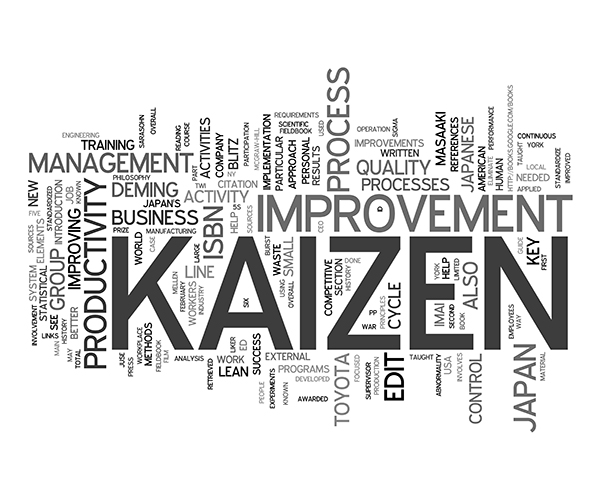Can a good scenario be bettered? Ask the Japanese and you would be surprised to hear their answer. A good scenario can always be bettered. They have a word for this – Kaizen
A Japanese term, Kaizen has swept the boardroom pundits off their feet with its simplistic profile and power-packed impact on business practices resulting in accelerated growth with increased efficiency.The Japanese firmly believe that there is always room for improvement no matter how good you think or your customers think you are. Because the minute you start thinking that you have arrived, your human instinct is to ease up a bit. To relax a bit. To feel ‘OK, things are perfect now. I don’t have to keep looking over my shoulder for the next competitor to catch up. I am far, far ahead of the race.’ The minute this sinks in, remember, you have lost the edge. The drive and ambition that made you the leader of the pack has suddenly lost its shine.
Management gurus figured this out and realised the dangerous pitfall that lay ahead of such complacency, and with commendable swiftness incorporated Kaizen into their regime.
Kaizen: Meaning And How It Works
So, what is Kaizen and how does it work? And why do management gurus and corporates stress upon its importance so vehemently? Kai means change and Zen means good. So Kaizen means ‘good change’.
Translated, that means the continuous improvement of established processes and functions of a company. Every organisation has a style sheet that sets down rules, regulations, policies and strategies of a company in a black and white format. These are methods which enable the company to do good business. Kaizen mindset is such that it teaches everyone in the organisation – from the proprietors to the lowest rung employee – to constantly look for improving these set methods, to head towards the same goal of better business. This is achieved through individual contribution, creativity and ingenuity aiding the process.
The masters of Kaizen believe that it does not start one fine day when it dawns on the proprietor that his organisation needs improvement. It is a continuous process and there are certain rules of Kaizen that one needs to understand, imbibe and inculcate amongst all employees.
Kaizen has identified 5S that every employer needs to follow, and ensure that everyone down the line also follows.

The 5S:
Seiri: Sort Out. The first step towards good business practice is to sort out your priorities. Daily working of an organisation automatically increases paper flow in the office. Why just paper? Even online documents, mails, follow-ups on orders, fresh orders…all of it multiplies manifold with the growth of an organisation. The tricky part is not to get overwhelmed by all this and not to let the chaos get the better hand. So, the first step is to sort out. Create as many folders as you think are necessary. Mark them as ‘Critical’, ‘Most important’, ‘Check Later’, ‘Useless’ or something else. This can be done for both offline and online documentation.
Seiton: Organise. Sorting out is fine. But the second most vital step is to organise. If you pull out a file, ensure it is put back there, from where it was taken. Keeping things in the place designated to them ensures smoother workflow, so that employees do not waste a lot of time searching for things.
Seiso: Shine. Clutter is hugely stressful. Surfaces need to be without any mess. Can you imagine a customer walking in and finding a messy counter top? Workstations need to be sparkling clean. De-clutter with smartness. The good thing is that if you follow the first two requirements of Sorting and Organising, Shining is easy.
Seiketsu: Standardisation. Every organisation needs to set standards for itself and ensure that it achieves that benchmark. This is true of quality as well as efficiency. Great quality but undue time taken to deliver a product irks customers and can adversely affect sales.
Shitsuke: Self-discipline. All the goodness of an organisation will come to naught, if employees do not follow self-discipline. Personal hygiene and regularity in attendance are two important aspects of self-discipline. It would also help if employees are provided uniforms and company ID cards. Not only do these add to company image and security, it also goes a long way in creating a sense of belonging with the company.
The Benefits Of Kaizen
One of the greatest benefits of implementing Kaizen is that it involves every employee and urges them to contribute towards change; small changes that make a difference to the working process – it involves identifying a problem at its source and solving it. A study shows that when the management is serious about Kaizen and its implementation, results are fabulous.
In companies that encourage Kaizen, every employee gives about 25 suggestions every year and about 90 per cent of them are utilised. Toyota, the automobile manufacturing company, has been one of the first users of Kaizen. In India, Toyota has achieved maximum benefits with its usage. Worldwide, the Toyota system is now regarded as the Toyota Production System (TPS) and Kaizen consultancy firms often use this system as the prototype. In 1999, at one U.S. plant, 7,000 Toyota employees submitted over 75,000 suggestions, of which 99 per cent were implemented.
With increased job satisfaction, the attrition rate is lower. Employees are happier and put in their best into the job. Improved productivity and quality, better customer service, better space utilisation, neater workspaces and lesser waste are the automatic spin-offs of good Kaizen.
Since Kaizen believes in the principle of rewarding everyone involved in a process and not just one individual, teamwork is also encouraged and individual egos learn to take a backseat.
Kaizen And The Optical Industry
With increasing awareness of Kaizen and its benefits, several optical manufacturing companies have also implemented the system. Like the Italian eyewear company Luxottica. The company takes on special Kaizen trained engineers to monitor their manufacturing processes. There are several Kaizen consultancy services that specialise in optical manufacturing companies too. Like the Japanese company Hirayama Consultancy Services that explains through a case study how Kaizen can improve the optical industry.
There was a company A, an optical instrument manufacturing company that was doing contract manufacturing successfully for many years. But many of its clients moved to overseas manufacturers and company A’s production in the domestic market dropped by half. The company then took on the services of Hirayama Consultancy Services and the results are there to see in the image below.

Kaizen is not just for optical manufacturing companies. It works just as effectively for optical stores as well – specially the five Kaizen rules. It is a key managerial technique that can be upgraded to achieve better results.












